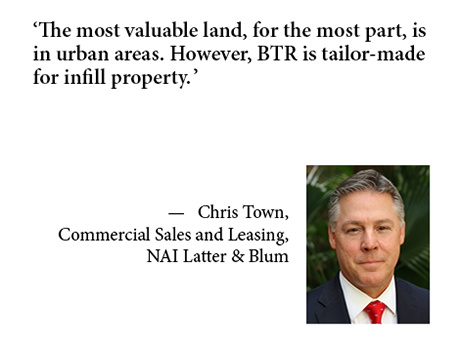The multifamily sector is under general disruption from a variety of factors, such as falling valuations, financing difficulties, questions about forward net operating income, shifts in regulations and more. Chris Town, who works in commercial sales and leasing at NAI Latter & Blum in Baton Rouge, La., is an expert in single-family rental (SFR) and built-to-rent (BTR) investment sales. Town says that there are challenges, but a solid future ahead for the sector.
The overarching challenges take the form of the Federal Reserve interest rate hikes. “It’s the major factor behind the immediate slowdown of home construction and home buying,” Town explains. “Another factor, of course, is land. These are true whether you’re talking true multifamily or the submarkets of BTR and SFR.”
A combination of factors has created a tug-of-war among incentives. High interest rates, with home prices at or near historical highs, mean millions of people need places to live. Many of these potential homeowners have families and want the ameliorations and amenities of a detached single-family housing.
“Depending on the metric and organization’s research used, you could say the country is five to six million units short on single-family homes,” Town says.
The Larger Economy’s Impact on the Sector
BTR and SFR are logical solutions, however they face not only land constraints but also high building costs that grew 39.2 percent from July 2019 to July 2023, according to the government’s Producer Price Index data.
Part of those cost increases are a result of a multidecade labor shortage problem. “The lack of labor is going to remain a factor because the crafts folks that actually do the construction are retiring or semi-retiring.” There aren’t enough younger people interested, and the country lacks realistic and effective immigration policy, so the construction labor force is constricted, according to Town.
There are also the Federal Reserve’s actions that the industry must consider. “Fed Chair Jay Powell wants to tamp down the labor market,” as rising demand and resulting wages represent an inflationary factor. But this approach can be part of a vicious circle, as employer demand won’t magically decrease.
“You can’t go down a street without seeing a hiring sign, whether it’s a restaurant, service industries, all the blue-collar employers, etc. They all need people, and they’re trying to hang on to the folks they have. So, without belaboring the point, labor in and of itself has been and will remain a major factor for the foreseeable future.”
Attitudes Toward SFR/BTR
“SFR/BTR is a natural investment vehicle” for institutions, Town notes. However, resistance towards these institutional investments has grown. Large institutional investors currently only make up a few percent of the SFR market constituents, Town says, adding, “However, they intend to make up a larger portion; and if conditions change, they will, because they have the money.”
One good sign was some recent legislative differentiation between SFR and BTR to remove critical tax deductions for owners of more than 50 single-family units. There was an explicit exemption for BTR in the Stop Predatory Investing Act. The concern is that institutions have discouraged lower-income, first-time buyers from purchasing existing homes as big buyers move quickly and pay cash.
At the same time, more than 90 percent of SFR is “mom-and-pop” ownership, Town says: “Millions of people own two, three, four, six units. Another part of that is, it’s bothersome that a number of people look at the housing issue as a zero-sum game.”
The need for big investment is critical as millions of people have shifted to the South and West from traditional population centers. Those areas need extensive increases in housing, especially rental houses and townhouses, which means invested capital. But the available land is often away from more populous areas and “those renters in reality want to be around density, they want to be around lifestyle, they want to be around work, they want to be around activity,” notes Town. “You move them to the outskirts of the city, and they’ve got a lawn.” No one wants to drive a half an hour to work, a restaurant or a meeting place with friends.
That inconvenience, however, could open opportunities for mixed development within the BTR world. That typically needs a partnership between a home building and commercial builder to bring both necessary aspects.
“The most valuable land, for the most part, is in urban areas,” Town explains. “However, BTR is tailor-made for infill property. The problem is, as everyone knows, they’re not making any more land.” Purchasing space to build is pricey, making it hard for developers to make a needed profit in metro areas.
However, BTR currently “is not keeping up and is not necessarily moving in parallel” to SFR, Town thinks.
Given current conditions, one of the better strategic plays at the moment is to look for land ahead of building plans. “Anytime you can get land at a reasonable price, one would probably be wise to get that” because land is the fundamental requirement developers can’t work around.
This article was written in conjunction with NAI Global, a content partner of REBusinessOnline. For more articles from and news about NAI Global, click here.


